The Northern Territory is the perfect place to learn about Indigenous Australia, to witness the connection between Indigenous people and the land, and to appreciate the unique art that has developed within the world’s oldest living culture. Learning the stories of the traditional custodianship of the land can also lead to ecologically responsible tourism.
Going on Tour in the Northern Territory
By far the best way to explore this vast land is to immerse yourself in local culture and make a positive contribution to Indigenous communities with your tourist dollar. You can do that by choosing a tour company that is owned by, or employs, local Indigenous guides and fosters an understanding of the environment. Tourism Australia’s Discover Aboriginal Experiences is a comprehensive resource.
In the Top End, the popular destinations are Kakadu, Litchfield, and Nitmiluk national parks and Western Arnhem Land. Kakadu Cultural Tours is owned by the Djabulukgu Association, which represents the people of Northern Kakadu and Western Arnhem Land. It is well placed to provide expert local guidance on its range of tours.
The Guluyambi Cultural Cruise on the East Alligator River is a great way to see the wildlife and learn how it sustains the local people throughout the year. Also in Kakadu, but in the south, is the outstanding Yellow Waters Cruises at Cooinda. The cruises, best at sunrise, are a highlight of Kakadu National Park, with spectacular wetland vistas, varied birdlife, expert commentary, and one of your best chances to spot a croc up close in its natural habitat.

Also based in Cooinda, Kakadu Animal Tracks takes you into country with an Aboriginal guide for an unforgettable hands-on experience hunting, gathering, and tasting bush food.
With the option to view bizarre termite mounds aligned to the earth’s magnetic field, hike in monsoon rainforest, and swim under a waterfall, Litchfield National Park has it all – and just a day trip from Darwin. Ethical Adventures is a small-group tour company concentrating on Top End, particularly Litchfield, destinations. With a focus on environmental awareness and education as well as great recreational activities, it’s a terrific vision of responsible tourism.
Back in Darwin Sea Darwin Turtle Tracks contributes to the Austurtle research project and takes adventurous spirits beyond Darwin Harbor to a sea turtle nesting site.

A must-see destination in the Top End is spectacular Nitmiluk (Katherine) Gorge National Park. Nitmiluk Tours, owned and run by the Jaowyn Association, offers a range of tours, including unique cultural immersion ‘Footsteps’ tours, guided walks, canoe safaris, and helicopter flights.
Around Alice Springs in the stunning McDonnell Ranges, across to Kings Canyon (Wartarrka National Park) and down to Uluru-Kata Tjuta National Park, you can join Aboriginal guides to discover traditional customs and hear the Dreaming stories of the Red Centre. Trek Larapinta is a small-group tour company taking hikers along the spectacular Larapinta Trail. Focusing on sustainability, the company offers programs for volunteers to contribute to the care and maintenance of the trail, including removal of weeds and erosion control.
Not far from spectacular Kings Canyon, Karrke Aboriginal Cultural Experience offers on-country cultural immersion tours explaining bush tucker and medicine, dot painting, and Dreamtime stories. At Uluru, choose from a variety of Aboriginal guided tours at the Ayers Rock Resort, and the Uluru-Kata Tjuta Cultural Centre.

Aboriginal Art Sites and Art Centers
The paintings depicted in rock shelters in Kakadu National Park, Arnhem Land, and Nitmiluk National Park date back thousands of years. Painting styles changed significantly over the centuries and newer art can often be superimposed over older art. The iconic, abstract dot painting art of Central Australia, known as Western Desert painting, has its roots in the stories and law of the desert people and was traditionally depicted in the ephemeral desert sands and body art. The use of acrylics and canvas is a relatively recent adaptation that began in Papunya, 150 miles northwest of Alice Springs, in 1971, and helped bring Aboriginal art to world prominence.
Today, few visitors to the Northern Territory will want to leave without a piece of Aboriginal art to remember their experiences with this timeless culture and its contemporary custodians. For the artists themselves, painting is not only culturally strengthening, but also individually and economically significant. Authentic pieces usually come with a certificate naming the artist, language group, and community. For a list of artists, art dealers, and Aboriginal-owned businesses, check the list at Indigenous Art Code.

To experience the art and meet the artists, visit these Aboriginal-owned art centers (among others) found across the Northern Territory.





